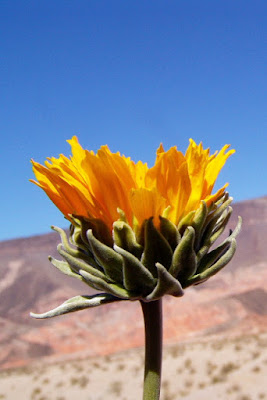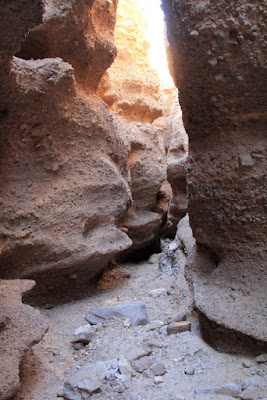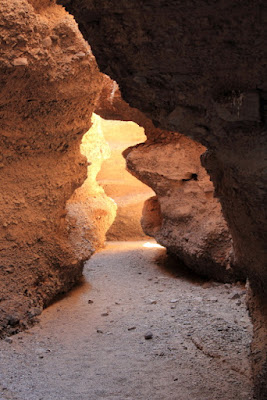All I can say is that who ever named Fortification Hill, never climbed the "Hill." A better name for this landmark might have been "Fortification Mountain," or "Misery Hill."
Sometimes I think that I may be getting a little senile becaue I made this hike twice - once in 2007 and once in 2017. However, the 2017 hike was significantly more difficult. Apparently, between the two hikes the earth's crust went through some type of an upheaval and added significant height and distance to the "Hill." Plus, due to global warming, I thought that I was going to expired from heat exhaustion on the most recent hike. Anyway, at the end of the day my conclusion was that twice up Fortification Hill was once too often! Be assured that the Fortification Hill hike will not ever be repeated in another RonnieAdventure!
To reach the Fortification Hill trailhead, we traveled south about one mile from Hoover Dam on U.S. Highway 93 to the Kingman Wash Road, which is a good place to check the suspension system on your vehicle -- at least the parts that are still attached when you reach the end of the road. (Anyone that has driven on washboard dirt roads will know what I'm talking about!)
Kingman Wash Road ends at a small cove on shoreline of Lake Mead, which is reported to be a popular fishing spot. We were not there for the fishing; however, much to our surprise, just before we reached the end of the road we found several rare Bear Poppy plants in bloom.
From the end of Kingman Wash Road, it is about another 2.5 miles of unmaintained 4 X 4 road to the Fortification Hill Trailhead; but the road was in good condition and 4-WD was not required
From the trailhead there are two different trails that can be followed part of the way to the face of Fortification Hill - one trail stays in the wash while the other trail goes immediately up to the ridgeline. The trail that stays in the wash was reported to be the easier trail, so we started in the wash.
After about a mile of steady climbing, the two trails come together near a place called "Funny Rocks." The rocks received their name because they are the only similar cluster of rocks on the trail and appear to have been placed there by humans, which is doubtful, rather than by nature. The rocks just appear to be "funny" when compared to the surrounding landscape.
From Funny Rocks the trail becomes quite steep all of the way to a vertical basalt cliff. The trail then parallels the base of the cliff until it reaches an area that required some Class 3 climbing, but we were able to negotiate the climb without any technical equipment.
 |
| 2007 Hike Picture |
Once over the Class 3 climb, the mesa is quite flat and it is less than 3/4 of a mile walk to the summit.
Views from the summit were spectacular in all directions. Although a little hazy, the views of Hoover Dam, Las Vegas, and snow-capped Mount Charleston were especially nice.
On the way back to the trailhead, at the Funny Rocks junction, I decided to follow the ridgeline trail rather than returning by way of the wash. It was more strenuous, but the wildflowers along the trail made the extra effort worthwhile.
Although we did not see any Desert Big Horned Sheep on this hike, the last time I made the trip we encountered several sheep along the way.
There are four main hiking trailheads that start from a common asphalt paved parking lot in Arizona, about three miles south of Hover Dam - Liberty Bell Arch, White Rock Canyon (aka Ringbolt Rapids), Arizona Hot Springs, and Spooky Canyon. The White Rock Canyon and Arizona Hot Springs trails both terminate at the Colorado River, so most people typically do the two trails as a single loop hike by following the Colorado River between the two trails.
We did not do the White Rock Canyon-Arizona Hot Springs trails this year, but I have made the hike in the past. After crossing under the new Interstate 11 bridges the White Rock Canyon trail stays in the main wash, while a connector trail to the original Liberty Bell Arch trail goes to the right. The new "short-cut" Liberty Bell Arch trail exits the wash about 0.75 miles from the bridge and saves going up-and-down a hill to connect to the original trail; plus taking the second trail to Liberty Bell Arch saves about one mile walking distance.
When we did the White Rock Canyon-Arizona Hot Springs loop, we decided to go in a counterclockwise direction by following White Rock Canyon all the way to the Colorado River.
White Rock Canyon is fairly open until the second Liberty Bell Arch trail exits to the right, then the canyon becomes much narrower and deeper for the remainder of the hike to "Ringbolt Rapids" on the Colorado River.
This area of the Colorado river was originally called Ringbolt Rapids, because in 1866 ringbolts were driven into the canyon walls to "allow the pioneering steamboat Esmerelda to affix a line to it and draw itself up through the rapids by means of its capstan, to complete its voyage to Callville." After completion of Hoover Dam, the Ringbold Rapids were covered by the Colorado River.
The Colorado River between Hoover Dam and Willow Beach (about 20 miles downstream) flows through an area known as Black Canyon. This part of the Colorado River is very popular with Kayakers. Just as we reached the river, a number of kayakers passed by, which made me add this float trip trip to my bucket list. .
We then followed the Colorado River downstream to Arizona Hot Springs.
The hot springs originate up the canyon from the river, so a metal ladder has been installed in the canyon to assist people in climbing up a steep pour-over. Once above the pour-over, the trail stays in a narrow canyon and the water is only several inched deep, except in placer where people have made sandbag dikes between the canyon walls to create deeper swimming pools. Since many people like to swim or lay in the pools in their birthday suits, it is not wise to take too many group pictures in the narrows.
Continuing up Hot Springs Canyon there are several different trails that can be followed, but they all arrive back at the same trailhead parking lot.
DIFFERENT HIKE: The Spooky Canyon trailhead leaves from the same parking lot and is one main slot drainage systems in the area that also has a few side canyons. This canyon is a popular resting place for Desert Bighorn Sheep and sheep scat can be found throughout the canyon.
There is very little vegetation in the canyon because the canyon is always cool and there is almost no direct sunlight that reaches the canyon floor. Toward the end of the canyon there is a large arch over a side passage that is worth visiting. Since "a picture is worth a thousand words," I'll end with 27,000 "words!"













































































